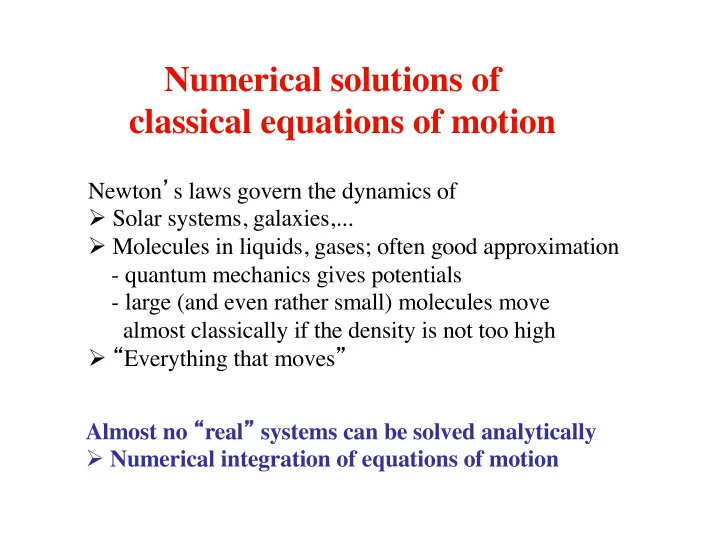

Numerical solutions of classical equations of motion Newton ’ s laws govern the dynamics of Ø Solar systems, galaxies,... Ø Molecules in liquids, gases; often good approximation - quantum mechanics gives potentials - large (and even rather small) molecules move almost classically if the density is not too high Ø “ Everything that moves ” Almost no “ real ” systems can be solved analytically Ø Numerical integration of equations of motion
One-dimensional motion Ø A single “ point particle ” at x(t) Equation of motion Notation: velocity: acceleration: Forces from: potential, damping (friction), driving (can be mix) Rewrite second-order diff. eqv. as coupled first-order:
Discretized time axis Start from given initial conditions: Simplest integration method: Euler forward algorithm Step error: Fortran 90 implementations: do i=1,nt do i=1,nt t=dt*(i-1) t0=dt*(i-1) a= acc(x,v,t) acc(x,v,t) x1=x0+dt*v0 x=x+dt*v v1=v0+dt* acc(x0,v0,t0) acc(x0,v0,t0) v=v+dt*a x0=x1; v0=v1 enddo enddo Ø Euler is not a very good algorithm in practice Ø Energy error unbounded (can diverge) Ø Algorithms with better precision almost as simple
Illustration of Euler algorithm: Harmonic oscillator (F = -kx) Integrated equations of motion for k=m=1;
Leapfrog algorithm (no damping) Taylor expand x(t) to second order in time step Contains velocity at “ half step ” : Substituting this gives Use similar form for v propagation: Leapfrog algorithm do i=1,nt t=dt*(i-1) a=acc(x,t) v=v+dt*a x=x+dt*v enddo Starting velocity from:
What is the step error in the leapfrog algorithm? Ø Might expect: Ø Actually: Ø Can be easily seen in a different derivation The Verlet algorithm Start from two Taylor expansions: Adding these gives the so-called Verlet algorithm Velocity defined by: Same as leapfrog, since
Properties of Verlet/leapfrog algorithm Ø Time reversal symmetry (check for round-off errors) Ø Errors bounded for periodic motion (time-reversal) Ø High accuracy with little computational effort Illustration: Harmonic oscillator (k=m=1), Code almost identical to Euler (swicth 2lines!) do i=1,nt t=dt*(i-1) a=acc(x,t) v=v+dt*a x=x+dt*v enddo Remember, initialize v at the half-step -dt/2!
Two equivalent Verlet/leapfrog methods Verlet: Leapfrog:
Error build-up in Verlet/leapfrog method Error in x after N steps, time Difference between numerical and exact solution: Inserting this in Verlet equation gives Discretized second derivative: The equation of motion for the error is thus:
Assume smoothness on scale of time-step, use continuum derivative (imagine a high-order interpolating polynomial between points) Exact solution satisfies: We are thus left with: Integrate to obtain error after time T: Worst case: no error cancellations (same sign for all n):
Verlet/leapfrog methods for damped systems We assumed velocity-independent forces in leapfrog method; With velocity dependent we need v n but have only v n+1/2 To study this problem, separate damping from rest of force Consider approximation: The error made in a is which gives x-error We can do a second step using This renders the error in x
Summary; leapfrog algorithm with damping: v n used here in a n Requires more work than standard leapfrog:
Runge-Kutta method Classic high-order scheme; error (4th order) Consider first single first-order equation: Warm-up: 2nd order Runge-Kutta Use mid-point rule: But we don ’ t know Approximate it using Euler formula; Sufficient accuracy for formula:
4th-order Runga-Kutta (the real thing) Uses Simpson ’ s formula: Need to find approximations for Somewhat obscure scheme accomplishes this (can be proven correct using Taylor expansion)
Runge-Kutta for two coupled equations
Equations of motion, Runge-Kutta algorithm Including damping is no problem here
The RK method does not have time-reversal symmetry Ø Errors not bounded for periodic motion Ø Time-reversibility important in some applications harmonic oscillator (k=m=1) Advantages of RK relative to leapfrog: Ø Variable time-step can be used (uses only n-data for n+1) Ø Better error scaling (but more computations for each step)
What algorithm to use? Recommendation In the case of energy-conserving systems (no damping or external driving forces) • Use the Verlet/leapfrog algorithm - good energy-conserving property (no divergence) In the case of non-energy-conserving systems (including damping and/or external driving forces) • Energy is not conserved, so no advantage for Verlet • Use the Runge-Kutta algorithm - smaller discretization error for given integration time T
Recommend
More recommend